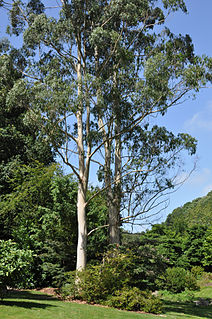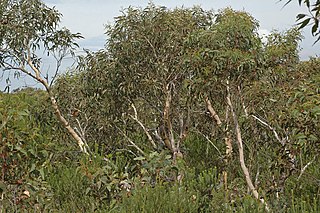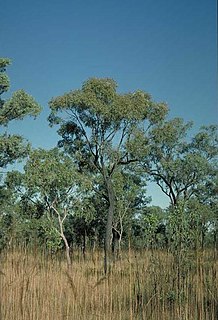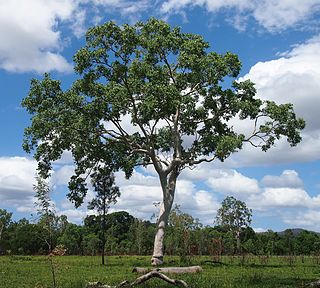
Eucalyptus dalrympleana, commonly known as mountain gum, mountain white gum, white gum and broad-leaved ribbon gum, is a species of tree that is endemic to southeastern Australia. It has smooth bark, lance-shaped adult leaves, flower buds in groups of three or seven, white flowers and cup-shaped, bell-shaped or hemispherical fruit.

Eucalyptus crebra, commonly known as the narrow-leaved ironbark, narrow-leaved red ironbark or simply ironbark, and as muggago in the indigenous Dharawal language, is a species of small to medium-sized tree endemic to eastern Australia. It has hard, rough "ironbark" from its trunk to small branches, linear to lance-shaped adult leaves, flower buds in groups of seven, nine or eleven, white flowers and cup-shaped, barrel-shaped or hemispherical fruit. A variable species, it grows in woodland and forest from the Cape York Peninsula to near Sydney. It is an important source of nectar in the honey industry and its hard, strong timber is used in construction.

Eucalyptus melanophloia, commonly known as silver-leaved ironbark, is a species of tree that is endemic to northeastern Australia. It is a small to medium-sized tree with rough, hard ironbark on the trunk and branches. The crown is usually composed of juvenile leaves that are dull, glaucous, sessile and arranged in opposite pairs. The flower buds are arranged in groups of seven, the flowers white and the fruit cup-shaped to hemispherical.

Eucalyptus staigeriana, commonly known as the lemon-scented ironbark, is a species of small ironbark tree that is endemic to the Cape York Peninsula. It has rough ironbark on the trunk and branches, lance-shaped to egg-shaped leaves that smell of lemons when crushed, flower buds in groups of seven, white flowers and oval to spindle-shaped fruit.

Eucalyptus camphora, commonly known as swamp gum is a flowering plant that is endemic to south-eastern Australia. It is a species of small to medium-sized tree with smooth bark, sometimes rough at the base, broadly lance-shaped to egg-shaped or elliptic adult leaves, flower buds in groups of seven, white flowers and conical fruit. There are two subspecies, subspecies camphora, commonly known as broad-leaved sally or swamp gum and subspecies humeana, commonly known as mountain swamp gum.

Eucalyptus racemosa, commonly known as snappy gum or narrow-leaved scribbly gum, is a species of small to medium-sized tree that is endemic to eastern Australia. It has smooth, mottled bark, lance-shaped to curved or egg-shaped adult leaves, flower buds in groups of between seven and fifteen, white flowers and cup-shaped, conical or hemispherical fruit.

Eucalyptus caleyi, commonly known as Caley's ironbark or Ovenden's ironbark is a species of small to medium-sized tree, endemic to eastern Australia. It has brown or black "ironbark" on the trunk and main branches, dull bluish grey lance-shaped to egg-shaped adult leaves, flower buds in groups of seven, white flowers and barrel-shaped or conical fruit. It grows on the Central and Northern Tablelands of New South Wales and in south-eastern Queensland.

Eucalyptus jensenii, commonly known as Wandi ironbark, is a species of tree that is endemic to northern Australia. It has hard, coarse black "ironbark", egg-shaped to lance-shaped adult leaves, flower buds in groups of seven, creamy white flowers and barrel-shaped to conical fruit.
Eucalyptus atrata, commonly known as the Herberton ironbark or blue-leaved ironbark, is a small tree that is endemic to Queensland. It has hard, black "ironbark" on the trunk and all but the thinnest branches, lance-shaped adult leaves, buds usually arranged in groups of seven, white flowers and cup-shaped to hemispherical fruit. It is characterised by the blue-grey, powdery bloom on its leaves and flower buds.

Eucalyptus decorticans, commonly known as the gum-top ironbark, is a species of tree that is endemic to Queensland. It has rough, dark grey or black "ironbark" on the trunk and larger branches, smooth white bark on the thinner branches, lance-shaped to curved adult leaves, flower buds in groups of seven, white flowers and conical, cup-shaped or barrel-shaped fruit.
Eucalyptus exilipes, commonly known as the fine-leaved ironbark, is a species of medium to tall tree and is endemic to Queensland. It has dark grey or black "ironbark", linear to narrow lance-shaped adult leaves, flower buds in groups of seven, white flowers and cup-shaped to shortened spherical fruit. It is similar to E. crebra, differing only in the length of the pedicels.
Eucalyptus melanoleuca, commonly known as yarraman ironbark or nanango ironbark, is a species of tree that is endemic to south-east Queensland. It has rough ironbark on the trunk and larger branches, smooth bark above, lance-shaped adult leaves, flower buds in groups of seven, white flowers and barrel-shaped, to cup-shaped or conical fruit.
Eucalyptus paedoglauca, commonly known as the Mount Stuart ironbark, is a small to medium-sized tree that is endemic to a small area in Queensland. It has rough, dark ironbark, lance-shaped adult leaves, flower buds in groups of seven, white flowers and cup-shaped fruit. It is only known from a few hills near Townsville.

Eucalyptus platyphylla, commonly known as poplar gum or white gum, is a species of medium-sized tree that is endemic to Queensland. It has smooth. powdery bark, heart-shaped, egg-shaped to almost round leaves, flower buds in groups of seven, white flowers and conical to hemispherical fruit.

Eucalyptus rhombica is a small to medium-sized tree that is endemic to a small area of south-east Queensland. It has rough, ironbark on the trunk and larger branches, smooth bark above, lance-shaped adult leaves, flower buds in groups of seven, white flowers and cup-shaped or conical fruit.

Eucalyptus shirleyi, commonly known as Shirley's silver leafed ironbark, silver-leaved ironbark, or Shirley's silver leaved ironbark, is a species of small ironbark tree that is endemic to Queensland. It has rough ironbark on the trunk and larger branches, the thinnest branches glaucous, a crown composed of sessile, heart-shaped, egg-shaped or round juvenile leaves, flower buds in groups of seven, white flowers and cup-shaped to barrel-shaped fruit.

Eucalyptus virens, commonly known as the shiny-leaved ironbark, is a species of small to medium-sized tree that is endemic to Queensland. It has hard ironbark on the trunk and branches, narrow lance-shaped adult leaves, flower buds in groups of seven, white flowers and hemispherical fruit.
Eucalyptus farinosa is a species of small tree that is endemic to Queensland. It has hard, dark grey ironbark, egg-shaped to lance-shaped adult leaves, flower buds in groups of seven, white flowers and cup-shaped to barrel-shaped and ribbed fruit.

Eucalyptus pauciflora subsp. pauciflora, commonly known as snow gum, cabbage gum or white sally is a tree or mallee that is endemic to eastern Australia. It has smooth bark, glossy green, lance-shaped, curved or elliptical leaves, flower buds in groups of between nine and fifteen, white flowers and cup-shaped, hemispherical or conical fruit.
Eucalyptus scopulorum is a species of small tree that is endemic to a small area of northern New South Wales. It has rough ironbark on the trunk and branches, lance-shaped adult leaves, flower buds in groups of seven, white flowers and barrel-shaped or conical fruit.


















